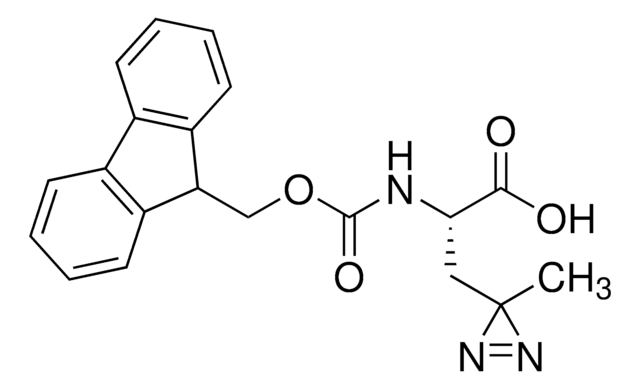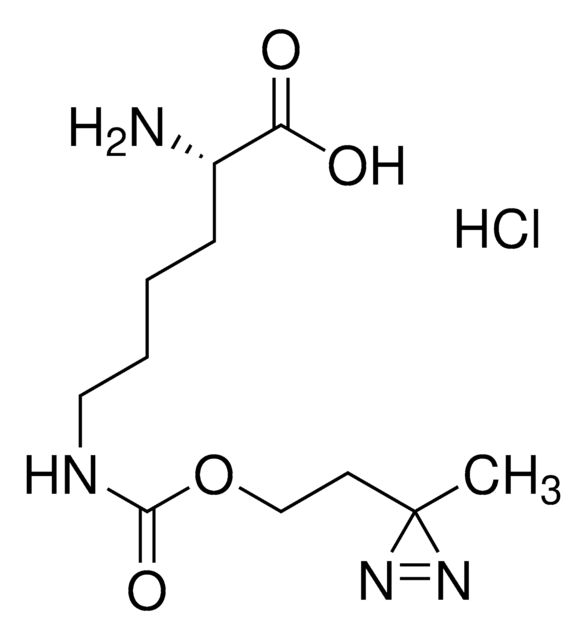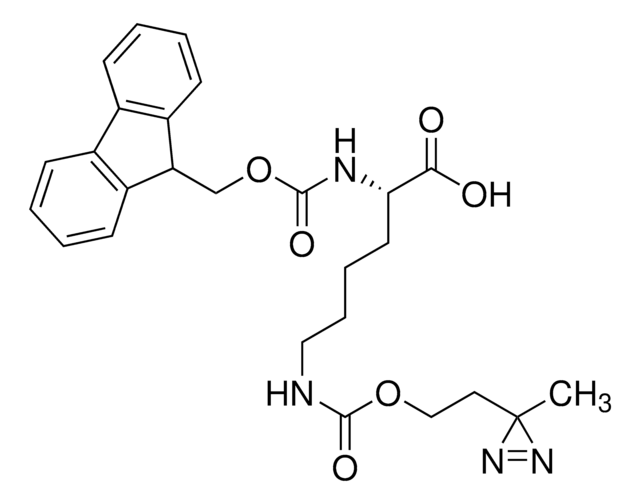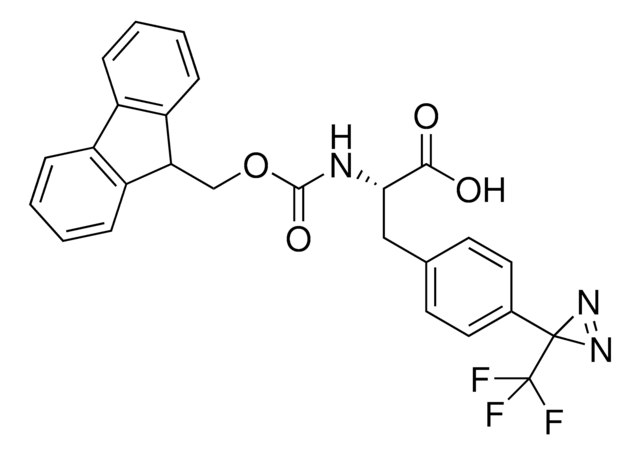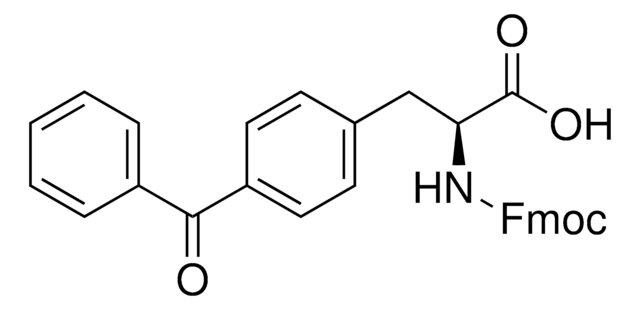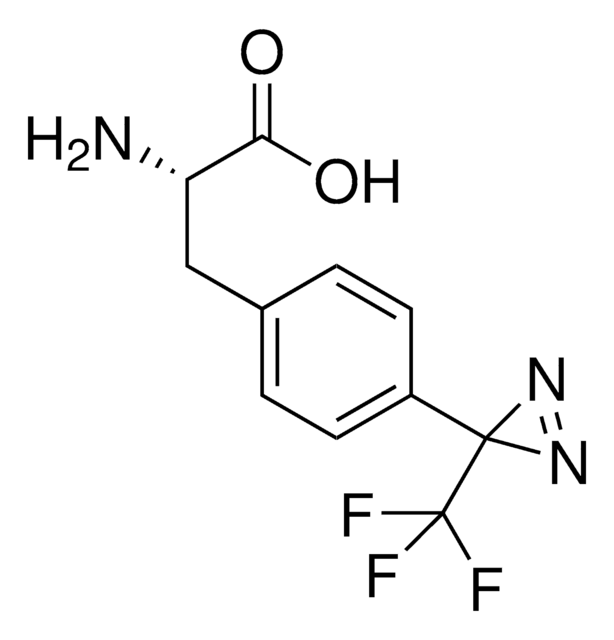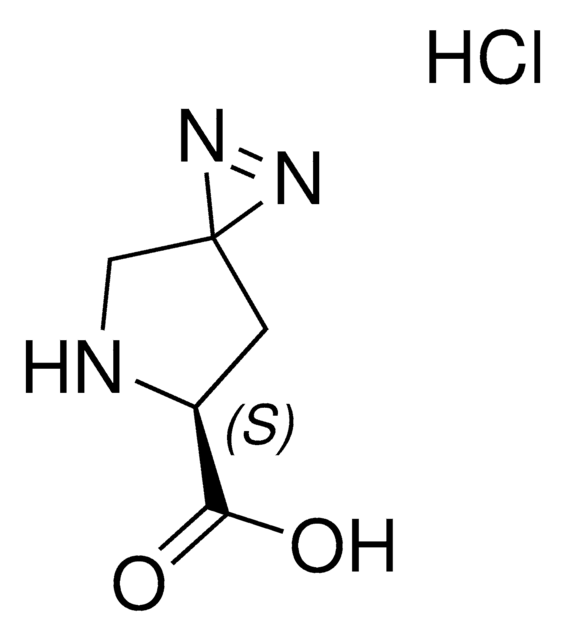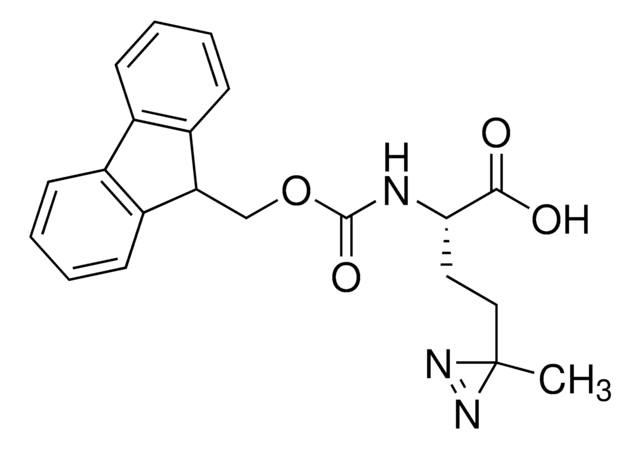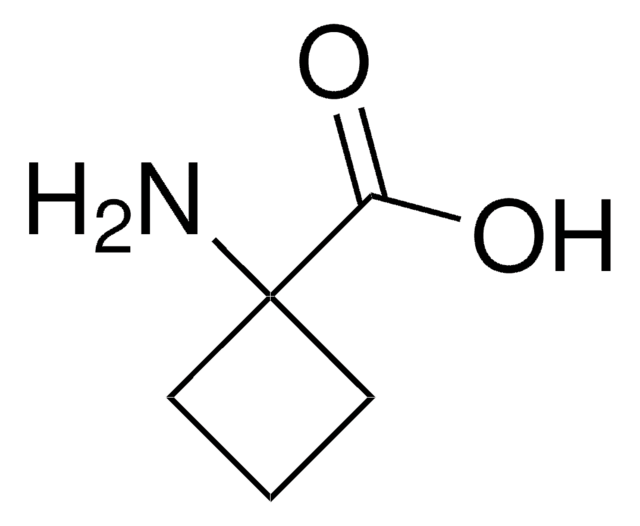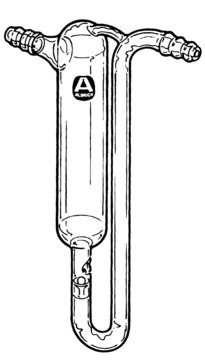907278
H-L-Photo-leucine HCl
≥98%
别名:
(S)-2-Amino-3-(3-methyl-3H-diazirin-3-yl)propanoic acid hydrochloride, (S)-2-Amino-3-(3H-diazirin-3-yl)butanoic acid hydrochloride, Diazirine amino acid, Photo-Leu, Photo-crosslinking amino acid, Photoprobe building block
登录查看公司和协议定价
所有图片(1)
About This Item
经验公式(希尔记法):
C5H10ClN3O2
分子量:
179.60
UNSPSC代码:
12352209
推荐产品
方案
≥98%
表单
solid
反应适用性
reaction type: solution phase peptide synthesis
存货情况
available only in USA
应用
peptide synthesis
储存温度
−20°C
应用
H-L-Photo-leucine HCl is a diazirine-containing leucine amino acid and multifunctional photo-crosslinker. Its incorporation into peptides or small-molecule probes and tools allows for photoaffinity labeling of cellular targets and protein-protein interactions upon UV light (∼360 nm) irradiation to form a covalent bond. This and other multifunctional probe building blocks will continue to accelerate drug discovery research for probing cellular mechanisms, target ID/validation, and understanding traditionally undruggable targets. An Fmoc-protected version is also available as 907391.
其他说明
Development, optimization, and structural characterization of an efficient peptide-based photoaffinity cross-linking reaction
for generation of homogeneous conjugates from wild-type antibodies
Mechanistic studies of a small-molecule modulator of SMN2 splicing
Protein-Polymer Conjugation via Ligand Affinity and Photoactivation of Glutathione S-Transferase
Direct Interaction between an Allosteric Agonist Pepducin and the Chemokine Receptor CXCR4
Photo-leucine and photo-methionine allow identification of protein-?protein interactions in living cells
Fishing for Drug Targets: A Focus on Diazirine Photoaffinity Probe Synthesis
Photo-affinity labeling (PAL) in chemical proteomics: a handy tool to investigate protein-protein interactions (PPIs)
for generation of homogeneous conjugates from wild-type antibodies
Mechanistic studies of a small-molecule modulator of SMN2 splicing
Protein-Polymer Conjugation via Ligand Affinity and Photoactivation of Glutathione S-Transferase
Direct Interaction between an Allosteric Agonist Pepducin and the Chemokine Receptor CXCR4
Photo-leucine and photo-methionine allow identification of protein-?protein interactions in living cells
Fishing for Drug Targets: A Focus on Diazirine Photoaffinity Probe Synthesis
Photo-affinity labeling (PAL) in chemical proteomics: a handy tool to investigate protein-protein interactions (PPIs)
相关产品
产品编号
说明
价格
警示用语:
Danger
危险声明
危险分类
Self-react. C
储存分类代码
5.2 - Organic peroxides and self-reacting hazardous materials
WGK
WGK 3
Christopher J Shaffer et al.
Journal of the American Society for Mass Spectrometry, 27(4), 633-645 (2016-01-29)
Noncovalent complexes of hydrophobic peptides GLLLG and GLLLK with photoleucine (L*) tagged peptides G(L* n L m )K (n = 1,3, m = 2,0) were generated as singly charged ions in the gas phase and probed by photodissociation at 355
Bojie Zhang et al.
Journal of the American Society for Mass Spectrometry, 27(3), 552-555 (2015-12-19)
Protein footprinting combined with mass spectrometry provides a method to study protein structures and interactions. To improve further current protein footprinting methods, we adapted the fast photochemical oxidation of proteins (FPOP) platform to utilize carbenes as the footprinting reagent. A
Andrew L MacKinnon et al.
Journal of the American Chemical Society, 129(47), 14560-14561 (2007-11-07)
Photoaffinity labeling is a powerful tool to identify protein targets of biologically active small molecules, yet is often limited by the size, chemical properties, and availability of photoreactive groups. We report an improved synthesis of photo-leucine, a diazirine-based photoreactive analogue
Christopher J Shaffer et al.
Journal of the American Society for Mass Spectrometry, 27(7), 1176-1185 (2016-04-10)
We report a combined experimental and computational study aimed at elucidating the structure of N-terminal fragment ions of the c type produced by electron transfer dissociation of photo-leucine (L*) peptide ions GL*GGKX. The c 4 ion from GL*GGK is found
Nicholas Vance et al.
Bioconjugate chemistry, 30(1), 148-160 (2018-12-20)
Site-specific conjugation of small molecules to antibodies represents an attractive goal for the development of more homogeneous targeted therapies and diagnostics. Most site-specific conjugation strategies require modification or removal of antibody glycans or interchain disulfide bonds or engineering of an
我们的科学家团队拥有各种研究领域经验,包括生命科学、材料科学、化学合成、色谱、分析及许多其他领域.
联系技术服务部门